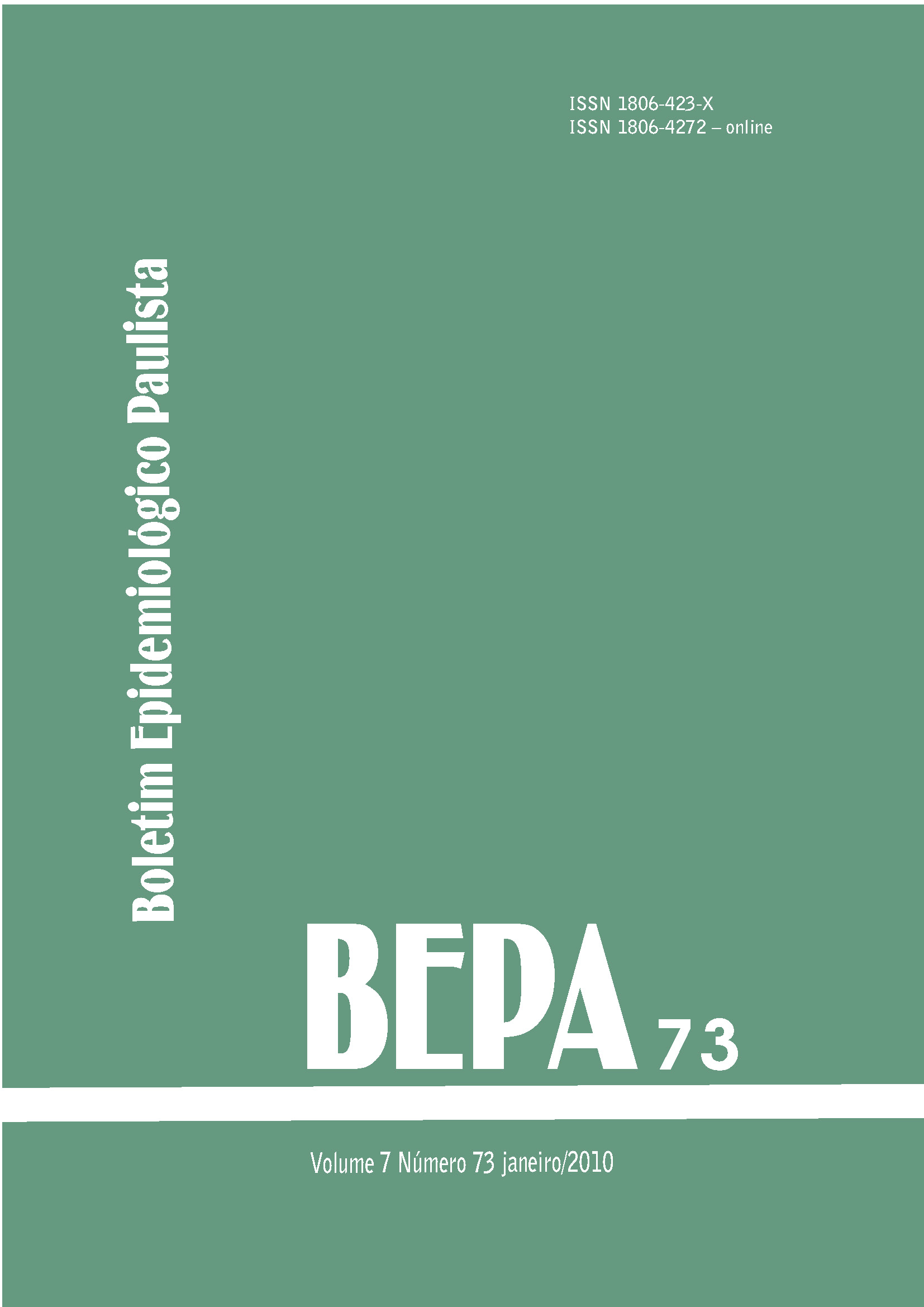Abstract
The objective of this paper was verifying the evolution of patients who obtained treatment discharge due to cure from Tuberculosis (TB), regarding the occurrence of recidivation, during the period comprised between 2002 and 2003. The method involved a transversal retrospective study, with the following inclusion criteria: TB cases with positive cultures, HIV positives, >18 years old, discharged from TB treatment and with outpatient clinic follow up, in a reference service for HIV/Aids attention in São Paulo (SP), Brazil. The following variables were evaluated: age, sex, clinical presentation, hospitalization, case type, TB treatment program and eventual changes in the program, hepatotoxicity, drug resistance, alcoholism, smoking, use of drugs, HAART, CD4, viral load, and immunodeficiency classification. In order to detect recurrence patients were subjected to 6,5 years follow up, after cure, by the information system TB-Web, from the Epidemiologic Surveillance Department of the Instituto de Infectologia Emilio Ribas. In order to evaluate statistic significance of the results, chi-square tests or Fischer´s exact test were both employed. A total of 39 patients were studied. There were 7 (17,9%) cases of recurrence. In the univariate analysis, not using the HAART [RR= 0,11 (IC95%:0,011-0,88); p = 0,05] proved to be associated to recurrence of tuberculosis. Results suggest that the use of HAART must be encouraged for patients registering coinfected with M. tuberculosis and HIV, in order to reduce TB recurrence.
References
World Health Organization - WHO [internet]. Global tuberculosis control: surveillance, planning, financing 2008. [acesso 07 dez 2008]. Disponível em: http://www. who/htm/tb/2008.393.
World Health Organization – WHO. [internet]. Building on and enhancing DOTS to meet the TB-related Millennium Development Goals. 2006 [acesso 12 dez 2008]. Disponível em: http://www.who/ htm/tb/2006.368.
Picon PD, Bassanesi SL, Caramori MLA, Ferreira RLT, Jarczewski CA,Vieira PRB. Fatores de risco para a recidiva da tuberculose. J Bras Pneumol. 2007;33(5):572-578.
Paula PF. Fatores associados à recidiva, ao abandono e ao óbito no retratamento da tuberculose pulmonar. [Tese de Doutorado]. São Paulo: Faculdade de Saúde Pública da USP; 2008.
Jasmer RM, Bozeman L, Schwartzman K, Cave MD, Saukkonen JJ, Metchock B, et al. Recurrent tuberculosis in the United States and Canada. Relapse or Reinfection? Am J Respir Crit Care Med. 2004;170:1360-6.
Maruza M, Ximenes RAA, Lacerda HR. Desfecho do tratamento e confirmação laboratorial do diagnóstico de tuberculose em pacientes com HIV/AIDS no Recife, Pernambuco, Brasil. J Bras Pneumol. 2008;34(6):394-403.
Caminero JA, Pena MJ, Campos-Herrero MI, Rodríguez JC, Afonso O, Martin C et al. Exogenous reinfection with tuberculosis on a European Island with a moderate incidence of disease. Am J Respir Crit Care Med. 2001;163:717-20.
Vree M, Huong NT, Duong BD, SY DN, Van LN, Hung NV et al. Survival and relapse rate of tuberculosis patients who successfully completed treatment in Vietnam. Int J Tuberc Lung Dis. 2007;11(4):392-7.
Viedma DG, Marin M, Hernangomez S, Diaz M, Serrano MJ, Alcala L et al. Tuberculosis recurrences. Reinfection Plays a role in a population whose clinical/epidemiological characteristics do not favor reinfection. Arch Intern Med. 2002;162.
Oliveira HB, Filho Moreira DC. Recidivas em tuberculose e seus fatores de risco. Rev Panam Salud Publica/Pan Am J Public Health.2000;7(4).
Lawn SD, Badri M, Wood R. Tuberculosis among HIV-infected patients receiving HAART: long term incidence and risk factors in a South African cohort. AIDS. 2005;19(18).
Belmiro VM, Neves DD, Carvalho SR. Tuberculosis profile in HIV+ patient before and after the use of high activity antiretroviral treatment. Rev Port Pneumol. 2004;10(3):205-15.
Brasil. Ministério da Saúde. [base de dados na internet]. Guia de Vigilância Epidemiológica 2005 [acesso em 12 jun 2009]. Disponível em: http:// www.bvsms.saude.gov.br/bvs/ publicacoes/Guia_Vig_Epid_novo2.pdf.
Brasil. Ministério da Saúde. Programa Nacional de DST e Aids. [base de dados na internet]. Recomendações para terapia anti-retroviral em adultos e adolescentes infectados pelo HIV 2007/2008 2007. [acesso em 10 jun 2009]. Disponível em: http://www.aids.gov.br/data/Pages/ LUMIS5F9787FCPTBRIE.htm.
Nakatami SM, Reason-Messias IJT, Burger M, Cunha CA. Prevalence of Mycobacterium avium and Mycobacterium tuberculosis in Blood Cultures of Brazilian AIDS Patients After Introduction of Highly Active Retroviral Therapy. BJID. 2005;9.

This work is licensed under a Creative Commons Attribution 4.0 International License.
Copyright (c) 2010 Camila de Fátima Costa, Nilton José Fernandes Cavalcante
